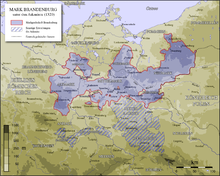Altmark
- See German tanker Altmark for the ship named after Altmark and Stary Targ for the Polish village named Altmark in German.

The Altmark (English: Old
Geography

The Altmark is located west of the Elbe river between the cities of Hamburg and Magdeburg, mostly included in the present-day[update] districts of Altmarkkreis Salzwedel and Stendal. In the west, the Drawehn hill range and the Drömling depression separate it from the Lüneburg Heath in Lower Saxony; the Altmark also borders the Wendland region in the north and the Magdeburg Börde in the south. Adjacent east of the Elbe is the historical Prignitz region.
The population is small. The
(21,500).History
Before the
In 936 the German king
For more than one and a half centuries, the lands east of the Elbe defied German control, until in 1134 Emperor

As the Brandenburg margraves expanded their territory during the course of the
As part of Brandenburg, from 1415 held by the
After
Rivers and lakes

The region is drained by the Elbe, joined by the Havel at Havelberg, and its left tributaries of the Milde-Biese-Aland system and the Jeetzel river.
The largest natural lake of the Altmark is the Arendsee.
Transport
Road
The Altmark is located off the main traffic routes. The Bundesautobahn 14 leads to the Bundesautobahn 2 from Hanover to Berlin, it however ends north of Magdeburg. A continuation through the Altmark towards Schwerin is planned. Beside which the Federal roads B71, B107, B188, B189, B190, B248 run through the region.
Rail
Stendal station is a stop on the Hanover–Berlin high-speed railway. Other lines include:
- Stendal–Salzwedel–Uelzen
- Wittenberge–Salzwedel–Oebisfelde
- Magdeburg–Stendal–Wittenberge
- Kalbe (Milde)
- Stendal–Tangermünde
Towns

- Salzwedel
- Oebisfelde
- Arendsee
- Seehausen
- Diesdorf
- Beetzendorf
- Klötze
- Mieste
- Gardelegen
- Kalbe (Milde)
- Bismark
- Osterburg
- Stendal
- Havelberg
- Tangermünde
- Tangerhütte
- Uchtspringe
Notes and references
- ^ Final Act of the Congress of Vienna
External links
- Altmarkwiki, the regional wiki for the Altmark
